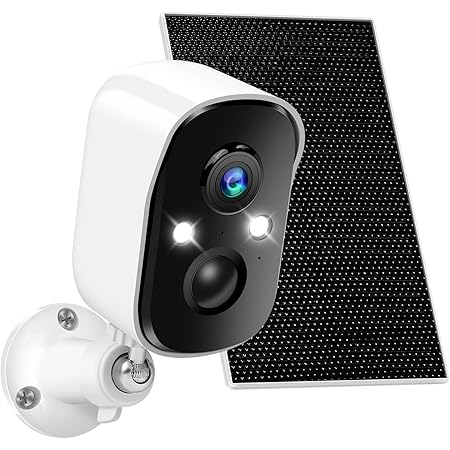Solar-powered security cameras are becoming increasingly popular, offering a blend of eco-friendliness and convenient security. But how do they manage to stay connected without needing constant access to a power outlet? The answer lies in clever engineering and the use of wireless connectivity. This article dives deep into the technology behind the wireless capabilities of these innovative cameras, exploring the various protocols, power management techniques, and considerations for optimal performance.
Understanding Wireless Communication Protocols

Wireless connectivity in solar security cameras predominantly relies on two main protocols: Wi-Fi and cellular data (4G LTE or 5G). Let’s explore each:
Wi-Fi Connectivity

Most solar security cameras utilize Wi-Fi for their primary connection. This establishes a local network link with your home router, enabling real-time video streaming, remote access through a mobile app, and two-way audio communication. The camera uses a small, integrated antenna to transmit and receive radio signals. The strength of this signal, and therefore the reliability of the connection, is influenced by several factors: the distance from the router, the presence of obstacles (walls, trees), and the router’s signal strength itself. Using a 2.4 GHz or 5 GHz band depends on the camera model and router capabilities, with 5 GHz often providing faster speeds but shorter range.
Cellular Data Connectivity (4G/5G)

Cellular connectivity provides a significant advantage, especially in areas with weak Wi-Fi signals or for locations far from your home network. These cameras have an embedded SIM card, allowing them to connect to a mobile network provider. This offers increased range and reliability, but usually comes at a monthly subscription cost for data usage. 5G cellular networks, where available, deliver faster speeds and lower latency, enhancing the streaming quality and responsiveness of the camera. However, 5G penetration isn’t universal yet, so 4G LTE remains a reliable alternative for many users.
Power Management and Solar Integration

The magic of solar security cameras lies in their ability to operate using energy harvested from sunlight. The system typically involves a solar panel, a rechargeable battery, and intelligent power management circuitry. Here’s how it works:
The solar panel converts sunlight into electrical energy, which then charges the battery. The camera utilizes this stored energy to power its components, including the wireless communication module. Intelligent power management is crucial for maximizing battery life and ensuring consistent operation. This involves techniques like:
- Low-power modes: The camera automatically switches to low-power modes when not actively recording or streaming video, conserving energy.
- Motion detection: Many cameras only record and transmit video when motion is detected, dramatically reducing energy consumption.
- Adaptive bitrate streaming: This technology dynamically adjusts the video quality based on available bandwidth and battery level, ensuring smooth streaming while minimizing power usage.
Factors Affecting Wireless Performance
Several factors can influence the performance of the wireless connection in your solar security camera. These include:
- Signal strength: Weak Wi-Fi signals or poor cellular coverage can lead to connectivity issues, dropped frames, and buffering.
- Obstacles: Physical barriers like walls, trees, and other electronic devices can interfere with wireless signals, reducing range and reliability.
- Weather conditions: Heavy rain, snow, or fog can attenuate wireless signals, particularly for Wi-Fi connections.
- Network congestion: A crowded Wi-Fi network or overloaded cellular network can impact performance.
- Camera placement: The camera’s location significantly impacts its ability to receive strong signals. Careful consideration of placement is critical.
Troubleshooting Wireless Connectivity Issues
Experiencing problems with your solar security camera’s wireless connection? Here’s a step-by-step approach to troubleshooting:
- Check signal strength: Use your smartphone or a Wi-Fi analyzer app to assess the strength of your Wi-Fi signal at the camera’s location. For cellular cameras, check your provider’s coverage map.
- Improve signal strength: Relocate the camera closer to your router or to an area with better cellular coverage. Consider using a Wi-Fi extender or a signal booster.
- Restart the camera: A simple restart can often resolve temporary glitches.
- Check the app: Ensure your camera’s app is up-to-date and that you have the correct login credentials.
- Contact your network provider or camera manufacturer: If the problem persists, contact your internet service provider or the camera manufacturer for support.
Comparing Solar Security Cameras
The market offers various solar security cameras with differing wireless capabilities and features. When choosing a camera, consider factors like:
- Wi-Fi and Cellular options: Determine which type of connectivity is most suitable for your location.
- Video quality: Higher resolution cameras often require more bandwidth.
- Storage capacity: Consider whether you need cloud storage or local storage on an SD card.
- Night vision: Essential for nighttime security.
- Battery life and solar panel efficiency: Check the manufacturer’s specifications to ensure sufficient battery life and solar charging capabilities.
By carefully considering these aspects, you can choose a solar security camera that meets your specific needs and provides reliable, wireless security for your home or business. Remember, reliable wireless connectivity is just one piece of the puzzle. Proper installation and regular maintenance also contribute to the longevity and effectiveness of your solar-powered security system.